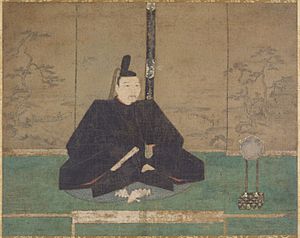Hōtoku facts for kids
Hōtoku (宝徳) was a special name for a period of time in Japan. It's like how we have years, but in old Japan, they also had "era names" called nengō. The Hōtoku era came after an era called Bun'an and before Kyotoku.
This period started in July 1449 and ended in July 1452. During these years, the ruler of Japan was Emperor Go-Hanazono.
Contents
Key Events of the Hōtoku Era
The Hōtoku era saw some important moments in Japanese history. These events often involved powerful leaders and connections with other countries.
Shogun Honored by Emperor
- May 8, 1449 (which was the 16th day of the 4th month in Hōtoku 1): The Shogun was a powerful military leader in Japan. During this time, the shogun was Ashikaga Yoshimasa. On this day, Emperor Go-Hanazono gave Shogun Yoshimasa a special sword as a gift. This showed the emperor's respect for the shogun.
First Visit from Ryukyu Islands
- 1451 (7th month of Hōtoku 3): For the very first time, a group of people on a diplomatic mission came to Japan from the Ryukyu Islands. These islands are south of Japan. They were officially welcomed in Heian-kyō, which is now known as Kyoto. This was an important step in building relationships between Japan and the Ryukyu Islands.
Letter to China
- 1451 (8th month of Hōtoku 3): Shogun Yoshimasa also reached out to other countries. He sent a letter to the Emperor of China. This shows that Japan was connected to other powerful nations even back then.
Related Pages
External Links
- National Diet Library, "The Japanese Calendar" -- historical overview plus illustrative images from library's collection
- Okinawa Prefectural Archives, 島津氏の琉球侵攻

All content from Kiddle encyclopedia articles (including the article images and facts) can be freely used under Attribution-ShareAlike license, unless stated otherwise. Cite this article:
Hōtoku Facts for Kids. Kiddle Encyclopedia.

